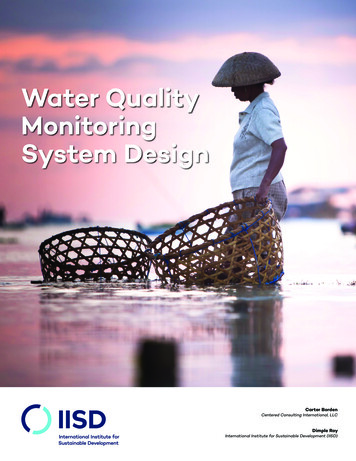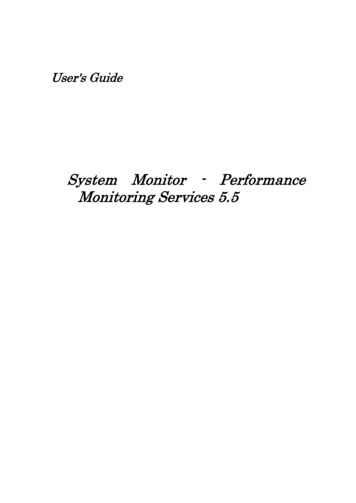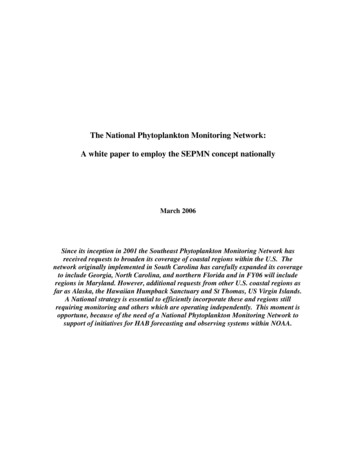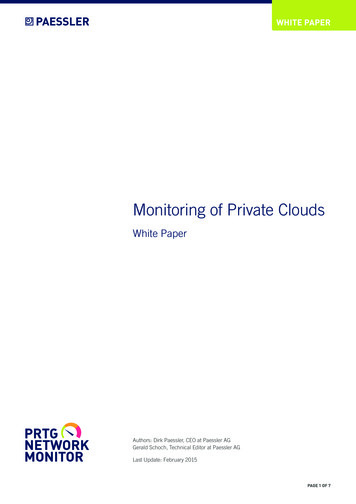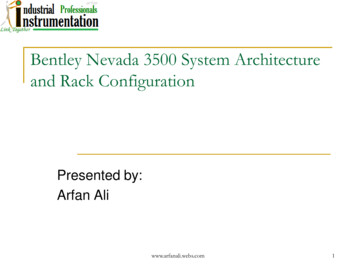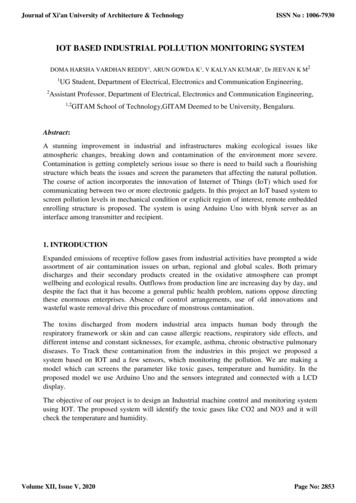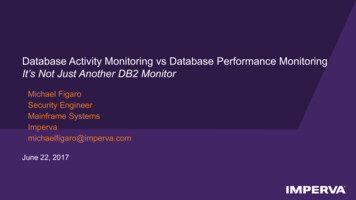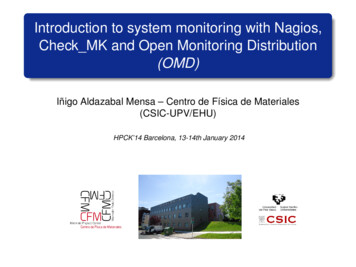
Transcription
Introduction to system monitoring with Nagios,Check MK and Open Monitoring Distribution(OMD)Iñigo Aldazabal Mensa – Centro de Física de Materiales(CSIC-UPV/EHU)HPCK’14 Barcelona, 13-14th January 2014
IntroNagiosCheck MKOMDIntroWhy monitoring?What to monitor?How to monitor?NagiosIntroductionActive and passive monitoringchecks, plugins and extensionsConsiderationsCheck MKIntroductionCheck MK AgentArchitectureMultisite front-endOMDIntroductionIncluded Software/packagesInstallationOMD General Overview - ComponentsIñigo AldazabalIntroduction to system monitoring with Nagios, Check MK and OMD
IntroNagiosCheck MKOMDWhy monitoring?What to monitor?How to monitor?IntroWhy monitoring?What to monitor?How to monitor?NagiosIntroductionActive and passive monitoringchecks, plugins and extensionsConsiderationsCheck MKIntroductionCheck MK AgentArchitectureMultisite front-endOMDIntroductionIncluded Software/packagesInstallationOMD General Overview - ComponentsIñigo AldazabalIntroduction to system monitoring with Nagios, Check MK and OMD
IntroNagiosCheck MKOMDWhy monitoring?What to monitor?How to monitor?Why monitoring?hardware failssoftware failsdisks get fullbackups not workingwater flows into Data Centers.We all do some kind of monitoring, but monitoring systems do not getbored, and do it 24x7.Is Good to now about these things as they happen, even betterbeforehand, in order to take correcting actions.The bad part: correcting the problems just as (or before) they happenmay give the false illusion that no job is being done on our partmaking your hard labour being underestimated.Iñigo AldazabalIntroduction to system monitoring with Nagios, Check MK and OMD
IntroNagiosCheck MKOMDWhy monitoring?What to monitor?How to monitor?What to monitor?In general:computersprintersnetwork equipmentservers (both pysical and virtual) / appliances.In our more spectific case (HPC systems):cluster head nodescompute nodes (disk space, NFS mounts, SMART status, .)backupsstorage systemsData Center environment (temperature, water, .).Iñigo AldazabalIntroduction to system monitoring with Nagios, Check MK and OMD
IntroNagiosCheck MKOMDWhy monitoring?What to monitor?How to monitor?How to monitor?We want a network monitoring solution providing monitoring alerting historical data for analysis.Lots of options, both free and proprietary software: Nagios,Zabbix, Groundwork, Cacti, Munin, .Extensibility is a must, as we are dealing with very specific (HPC)systems, and we do script things!We did choose Nagios (OMD/Check MK came later) :Well stablished, de facto industry standard.Long trajectory and big user base (i.e. support, tutorials, etc.).Very flexible notification system.Extensive set of plugins.Open SourceIñigo AldazabalIntroduction to system monitoring with Nagios, Check MK and OMD
IntroNagiosCheck MKOMDWhy monitoring?What to monitor?How to monitor?How to monitor?We want a network monitoring solution providing monitoring alerting historical data for analysis.Lots of options, both free and proprietary software: Nagios,Zabbix, Groundwork, Cacti, Munin, .Extensibility is a must, as we are dealing with very specific (HPC)systems, and we do script things!We did choose Nagios (OMD/Check MK came later) :Well stablished, de facto industry standard.Long trajectory and big user base (i.e. support, tutorials, etc.).Very flexible notification system.Extensive set of plugins.Open SourceYour mileage may vary. Any solution is better than no solution!Iñigo AldazabalIntroduction to system monitoring with Nagios, Check MK and OMD
IntroNagiosCheck MKOMDIntroductionActive and passive monitoringchecks, plugins and extensionsConsiderationsIntroWhy monitoring?What to monitor?How to monitor?NagiosIntroductionActive and passive monitoringchecks, plugins and extensionsConsiderationsCheck MKIntroductionCheck MK AgentArchitectureMultisite front-endOMDIntroductionIncluded Software/packagesInstallationOMD General Overview - ComponentsIñigo AldazabalIntroduction to system monitoring with Nagios, Check MK and OMD
IntroNagiosCheck MKOMDIntroductionActive and passive monitoringchecks, plugins and extensionsConsiderationsWhat is Nagios?Open Source computer and networkmonitoring system which monitors hostsand services, and alerts us when they gounder undesired behavoiur.What is monitored:Network services (SMTP, POP3, HTTP.)Network connected equipment (ping, SNMP.)Systems (CPU load, free disk space, hard disk health, backupstatus, .)How does it alerts:emailSMS.Iñigo AldazabalIntroduction to system monitoring with Nagios, Check MK and OMD
IntroNagiosCheck MKOMDIntroductionActive and passive monitoringchecks, plugins and extensionsConsiderationsBasic ConceptsHost: the physical equipments (ping).Services: Resources to be monitored within an specific hosts(http response, printer toner levels, hard diskSMART status, backups status,.).Plugins: Programs (scripts o executable code) which can be runfrom the command line in order to verify the state of a host orservice, tipycally named as check xxx (check http,check printer, check smart, check backup.).Contacts and Contact Groups: People to be notified and how they are notified.Time Periods: Week days and time intervals in which a host/service has to bemonitored.Iñigo AldazabalIntroduction to system monitoring with Nagios, Check MK and OMD
IntroNagiosCheck MKOMDIntroductionActive and passive monitoringchecks, plugins and extensionsConsiderationsActive and passive monitoringActive monitoring: ping,check http.Iñigo AldazabalPassive monitoring, asynchronousby nature: SNMP traps, securityalerts, .Introduction to system monitoring with Nagios, Check MK and OMD
IntroNagiosCheck MKOMDIntroductionActive and passive monitoringchecks, plugins and extensionsConsiderationsActive MonitoringRun on the Nagios server itself (“remote” checks): SNMP, ping,check http, check printer.Run on the systems being monitored (“local” checks): NagiosRemote Plugin Executor (NRPE)Iñigo AldazabalIntroduction to system monitoring with Nagios, Check MK and OMD
IntroNagiosCheck MKOMDIntroductionActive and passive monitoringchecks, plugins and extensionsConsiderationsPassive MonitoringRun on the remote hosts: Nagios Service Check Acceptor (NSCA)SNMP Traps: Net-SNMP SNMP Trap Translator (SNMPTT)Iñigo AldazabalIntroduction to system monitoring with Nagios, Check MK and OMD
IntroNagiosCheck MKOMDIntroductionActive and passive monitoringchecks, plugins and extensionsConsiderationsHost checksHosts are checked by the Nagios daemon at defined regularintervals (1 min. in OMD).Hosts that are checked can be in one of three different states:UPUNREACHABLEDOWNIñigo AldazabalIntroduction to system monitoring with Nagios, Check MK and OMD
IntroNagiosCheck MKOMDIntroductionActive and passive monitoringchecks, plugins and extensionsConsiderationsService checksService are checked by the Nagios daemon at defined regularintervals (1 min. in OMD).Services that are checked can be in one of four different states:OKWARNINGUNKNOWNCRITICALService checks are performed by plugins, which can return astate of OK, WARNING, UNKNOWN, or CRITICAL.When a service changes its state, Nagios takes appropiateaction.Detecting and dealing with state changes is what Nagios is all about.Iñigo AldazabalIntroduction to system monitoring with Nagios, Check MK and OMD
IntroNagiosCheck MKOMDIntroductionActive and passive monitoringchecks, plugins and extensionsConsiderationshost – services exampleIñigo AldazabalIntroduction to system monitoring with Nagios, Check MK and OMD
IntroNagiosCheck MKOMDIntroductionActive and passive monitoringchecks, plugins and extensionsConsiderationsNagios Plugins (I)Nagios itself does not provides any check. Everything is donethrough.PluginsPlugins are compiled executables or scripts (Perl scripts, shell scripts,etc.) that can be run from a command line to check the status or ahost or service. Nagios uses the results from plugins to determine thecurrent status of hosts and services on your network (tipycally namedcheck xxx).How are services monitored:Nagios runs the plugin (eg. check http).The plugin does “something” and gives the result back to Nagios.Nagios processes the result and takes the correspondingactions.Iñigo AldazabalIntroduction to system monitoring with Nagios, Check MK and OMD
IntroNagiosCheck MKOMDIntroductionActive and passive monitoringchecks, plugins and extensionsConsiderationsNagios Plugins (II)Plugin Sctructurecheck stuff [ HostIP ] [-w warning level ][-c critical level ]return values: 0(OK), 1(Warning), 2(Critical),3(Unknown)stdout: message optional performance dataPerformance data:label value[UOM];[warn];[crit];[min];[max]Iñigo AldazabalIntroduction to system monitoring with Nagios, Check MK and OMD
IntroNagiosCheck MKOMDIntroductionActive and passive monitoringchecks, plugins and extensionsConsiderationsNagios Plugins (II)Plugin Sctructurecheck stuff [ HostIP ] [-w warning level ][-c critical level ]return values: 0(OK), 1(Warning), 2(Critical),3(Unknown)stdout: message optional performance dataPerformance data:label value[UOM];[warn];[crit];[min];[max]Example:# ./check enviromux mini.py 192.168.1.123 -w 35 \-c 45 -s temperature1OK - Temperature CRAC-1 sensor reading is 31.6Celsius Temperature\ CRAC-1 31.6;35.0;45.0;0.;50.Iñigo AldazabalIntroduction to system monitoring with Nagios, Check MK and OMD
IntroNagiosCheck MKOMDIntroductionActive and passive monitoringchecks, plugins and extensionsConsiderationsNagios Plugins (III)There are plugins for:HTTP, POP3, IMAP, FTP, SSH, DHCP.CPU load, disk usage, memory usage, connected users, .routers, switches.Official Nagios plugins at http://nagiosplugins.orgPublic repository for Nagios plugins at Nagios Exchange with 3000plugins, addons, utils, . http://exchange.nagios.org/Iñigo AldazabalIntroduction to system monitoring with Nagios, Check MK and OMD
IntroNagiosCheck MKOMDIntroductionActive and passive monitoringchecks, plugins and extensionsConsiderationsNagios Plugins (III)There are plugins for:HTTP, POP3, IMAP, FTP, SSH, DHCP.CPU load, disk usage, memory usage, connected users, .routers, switches.Official Nagios plugins at http://nagiosplugins.orgPublic repository for Nagios plugins at Nagios Exchange with 3000plugins, addons, utils, . http://exchange.nagios.org/Do not reinvent the wheel! Search around for something similar first.Iñigo AldazabalIntroduction to system monitoring with Nagios, Check MK and OMD
IntroNagiosCheck MKOMDIntroductionActive and passive monitoringchecks, plugins and extensionsConsiderationsNagios Plugins - Local check example (I)#!/bin/bash# Counts number of files in /tmp. Harcoded levels w 50, c 100.count (ls -1 /tmp wc --lines)if [ count -lt 50 ] ; thenecho "OK - count files in /tmp /tmp count;50;100;;"exit 0elif [ count -lt 100 ] ; thenecho "WARNING - count files in /tmp /tmp count;50;100;;"exit 1elif [ count -ge 100 ] ; thenecho "CRITICAL - count files in /tmp /tmp count;50;100;;"exit 2elseecho "UNKNOWN - count files in /tmp /tmp count;50;100;;"exit 3fi# /usr/lib/check mk agent/local/filecount tmpCRITICAL - 126 files in /tmp /tmp 126;50;100;;# echo ?2Iñigo AldazabalIntroduction to system monitoring with Nagios, Check MK and OMD
IntroNagiosCheck MKOMDIntroductionActive and passive monitoringchecks, plugins and extensionsConsiderationsConsiderationsProsPlugins very easy to write/adapt.Can monitor almost eveything network connected (SNMP).Very flexible alerting system.A lot of existing plugins and addons.ConsHard to configure.Outdated and somehow confusing interface.Does not provide historical time series data, is “just“ an alertingsystem.Iñigo AldazabalIntroduction to system monitoring with Nagios, Check MK and OMD
IntroNagiosCheck MKOMDIntroductionActive and passive monitoringchecks, plugins and extensionsConsiderationsExtensions!Nagios extensions leverage the “cons“:Hard to configure NagiosQL, LConf, NConf, Centreon.Outdated and somehow confusing interface Thruk, Centreon,GroundWork.Does not provide historical time series data PNP4Nagios,nagiosgraphVisualization NagVisEven harder to configure!Iñigo AldazabalIntroduction to system monitoring with Nagios, Check MK and OMD
IntroNagiosCheck MKOMDIntroductionCheck MK AgentArchitectureMultisite front-endIntroWhy monitoring?What to monitor?How to monitor?NagiosIntroductionActive and passive monitoringchecks, plugins and extensionsConsiderationsCheck MKIntroductionCheck MK AgentArchitectureMultisite front-endOMDIntroductionIncluded Software/packagesInstallationOMD General Overview - ComponentsIñigo AldazabalIntroduction to system monitoring with Nagios, Check MK and OMD
IntroNagiosCheck MKOMDIntroductionCheck MK AgentArchitectureMultisite front-endCheck MK monitoring systemCheck MKCheck MK is a collection of extensions for Nagioswhich together with PNP4Nagios and NagVisconstitutes a complete, 100 % Open Source,IT-Monitoring-SystemMain components:check mk agent: automatic service recognition and configurationgenerator .Multisite: web frontend.Web Administration Tool - WATO: complete administration of aCheck MK-based system over a browser.Check MK Event Console: integrates the processing of logmessages and SNMP-Traps into the monitoring.Iñigo AldazabalIntroduction to system monitoring with Nagios, Check MK and OMD
IntroNagiosCheck MKOMDIntroductionCheck MK AgentArchitectureMultisite front-endCheck MK AgentNRPE multiple checks just one check per host passive checks inthe monitoring server!Automatic service recognition.More than 300 included checks.Iñigo AldazabalIntroduction to system monitoring with Nagios, Check MK and OMD
IntroNagiosCheck MKOMDIntroductionCheck MK AgentArchitectureMultisite front-endArchitecture of a Check MK based monitoring solutionIñigo AldazabalIntroduction to system monitoring with Nagios, Check MK and OMD
IntroNagiosCheck MKOMDIntroductionCheck MK AgentArchitectureMultisite front-endMultisite web front-endAnd all tied up by the “Multisite” web front end, giving access to allthe components.Iñigo AldazabalIntroduction to system monitoring with Nagios, Check MK and OMD
IntroNagiosCheck MKOMDIntroductionCheck MK AgentArchitectureMultisite front-endCheck MK Plugins - Local check example#!/bin/sh# /usr/lib/check mk agent/local/check mk dmraid# Checks status of a dmraid disk array.raid status ‘dmraid -s grep status awk ’{print 3}’‘if [ " raid status" "ok" ] ; thenecho "0 dmraid - OK - RAID Status: {raid status}"exit 0elseraid full info ‘dmraid -s paste -sd ","‘disks info ‘dmraid -r paste -sd ";"‘full errror {raid full info}" ; " {disks info}echo "2 dmraid - CRITICAL - RAID Status: " {raid status}" " {raid full info} " *** Disks info -- " {disks info}exit 2fi# /usr/lib/check mk agent/local/check mk dmraid0 dmraid - OK - RAID Status: okIñigo AldazabalIntroduction to system monitoring with Nagios, Check MK and OMD
IntroNagiosCheck MKOMDIntroductionIncluded Software/packagesInstallationOMD General Overview - ComponentsIntroWhy monitoring?What to monitor?How to monitor?NagiosIntroductionActive and passive monitoringchecks, plugins and extensionsConsiderationsCheck MKIntroductionCheck MK AgentArchitectureMultisite front-endOMDIntroductionIncluded Software/packagesInstallationOMD General Overview - ComponentsIñigo AldazabalIntroduction to system monitoring with Nagios, Check MK and OMD
IntroNagiosCheck MKOMDIntroductionIncluded Software/packagesInstallationOMD General Overview - ComponentsOMD - The Open Monitoring DistributionOMD“Bundle” of Nagios based monitoring software,integrated and configured in such a way that greatlysimplifies the installation, maintenance and update of thewhole system. Prebuilt packages are provided forenterprise distributions.Features:Multiple instances – sites – of the system in the same server (eg.test and production sites).Separate operators/users per instance.Trivial creation of new sites.Support for concurrent different OMD versions in one server.Iñigo AldazabalIntroduction to system monitoring with Nagios, Check MK and OMD
IntroNagiosCheck MKOMDIntroductionIncluded Software/packagesInstallationOMD General Overview - ComponentsOMD SoftwareNagiosnagios-pluginsnscacheck Check MKMK LivestatusMultisiteDokuwikiThruk.Iñigo AldazabalIntroduction to system monitoring with Nagios, Check MK and OMD
IntroNagiosCheck MKOMDIntroductionIncluded Software/packagesInstallationOMD General Overview - ComponentsInstallation example (SLES)First install the package matching your operating system:# zypper install omd-1.10-sles11sp3-31.x86 64.rpmNow create a monitoring instance (OMD calls this a “site” ):# omd create fooAnd let’s start the “site”, i.e. Nagios and all other processes (Nagios,apache, rrdcached.)# omd start fooAnd login to the “Multisite” we interface at http://localhost/foo andstart adding hosts / services.Iñigo AldazabalIntroduction to system monitoring with Nagios, Check MK and OMD
IntroNagiosCheck MKOMDIntroductionIncluded Software/packagesInstallationOMD General Overview - ComponentsComponentsIñigo AldazabalIntroduction to system monitoring with Nagios, Check MK and OMD
ReferencesReferencesNagiosNagios http://www.nagios.org/Nagios Plugins http://nagiosplugins.org/Nagios Exchange http://exchange.nagios.org/“Building a Monitoring Infrastructure with Nagios”, DavidJosephsen, Prentice Hall 2007Check MKThe Check MK Monitoring System:http://mathias-kettner.com/checkmk monitoringsystem.htmlThe Check MK Project:http://mathias-kettner.com/check mk.htmlOMDhttp://omdistro.org/Iñigo AldazabalIntroduction to system monitoring with Nagios, Check MK and OMD
What to monitor? How to monitor? How to monitor? We want a network monitoring solution providing monitoring alerting historical data for analysis. Lots of options, both free and proprietary software: Nagios, Zabbix, Groundwork, Cacti, Munin, . Extensibility is a must, as we are dealing with very specific (HPC) systems, and we do script .


